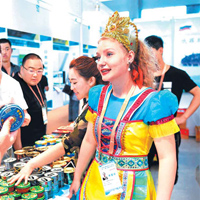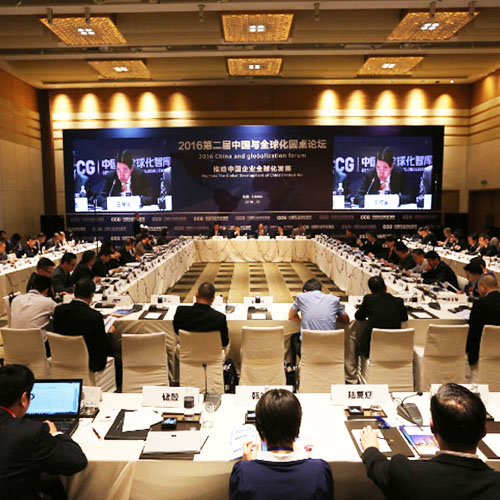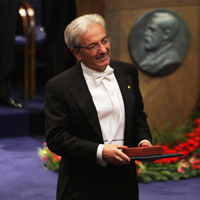- 当前位置:
- 首页>
- 活动>
- ���������������
���������������
CCG持续关注国际关系议题,推动中国与全球化的发展,积极开展国际交流,充分发挥智库“二轨外交”作用,在巴黎和平论坛、达沃斯世界经济论坛、慕尼黑安全会议等重要国际政策与意见交流平台上组织分论坛、边会、圆桌会议、晚宴等活动,促进国际政商学界对话,凝聚共识;CCG积极与各国政界、智库界、工商界开展“二轨外交”活动,每年常态化赴多国调研与交流,促进中外关系攸关方互动,保持与多国政策圈层的沟通渠道。
-

【China Daily】Gao Wei: Reform will help develop film market
China’s box office revenue stood at 4.5 billion yuan (around $680 million) in July, down 18 percent year on year, the first decrease in five years. [Photo/Xinhua]The import of Hollywood movies has influenced the development of contemporary Chinese movie market. China reformed its film industry in 1993, bringing about rapid development of the industry.From 1995 to 2001, China imported 10 foreign movies every year. After joining the World Trade Organization in 2001, China increased the number of imported films to 20 a year. The figure was further raised to 34 in 2012.From 1993 onwards, the Chinese film industry has realized a miraculous growth. Apart from the increase in the number of films produced every year, the annual box office returns in China jumped from 950 million yuan ($138 million) in 1995 to 45.71 billion yuan in 2016-58 percent of which came from Chinese movies. And the total number of movie screens in China has risen to 40,917, the highest in the world.Foreign movies have not only influenced the Chinese audience’s aesthetics and satisfied the demand of the Chinese market; they have also stimulated China’s movie production business. They have played the catalyst in the transformation of Chinese movie production model from extensive to industrialized and high-quality products, and provided higher reference standards and better learning materials for Chinese movie makers in terms of technology, material selection and distribution.Moreover, along with the gradual but steady increase in cooperation between China’s movie industry and Hollywood, Sino-US cultural exchanges have become more frequent. Chinese culture has spread in the United States through an increasing number of Chinese cultural symbols, products and stories in Hollywood movies and TV shows.Creating new requirements for film industry management, the emergence of new patterns in China’s movie market has stimulated systemic innovations. In 2004, Chinese movies for the first time generated higher box office returns than Hollywood movies and have maintained that comparative advantage since.The main reason the Chinese film industry has flourished and Chinese movies have made more money than Hollywood flicks is the government’s policy which, among other things, limits the number of new foreign movies that can be screened in the country in one year, puts a cap on foreign investment in cinema chains and has zero tolerance toward movie piracy.The Film Industry Promotion Law, which came into force on March 1 this year, however, signals the beginning of a new era for the movie industry, characterized by the rule of law. The government will now adhere to decentralization, combine tight and loose policies, simplify the examination and approval process for films, lower the barriers for entry to China’s movie market and further standardize the market order.The Chinese movie market is one of the largest in the world. The increasing number of Chinese-foreign co-productions has injected vitality into and helped the rapid development of the Chinese film industry. Chinese film companies and studios, on their part, are ready to participate in co-productions with foreign filmmakers and movie companies for win-win results.About AuthorGao Wei, a fellow at the Center for China and Globalization(CCG) and a researcher at the State Administration of Press, Publication, Radio, Film and Television of China.From China Daily,2017-4-1
2017年4月5日 -

【China Daily】China, Russia share path to prosperity
Visitors to the China-Russia Expo in Harbin, Heilongjiang province, check goods from Russia in June. The province has close trade ties with Russia. Wang Jianwei / XinhuaCoordination of Belt and Road, Eurasian Economic Union boosts development outlook for both countriesAt the Europlastic factory in Vladivostok, the largest city in the Russian Far East, workers use Italian-built machinery to make plastic bottle caps out of raw materials imported from China.It is a dynamic that largely reflects the current international business scene in Russia.The name "Europlastic" highlights an ambition cherished by many Russian enterprises: to thrive in the European market. Yet the company has almost no business in Europe, with overall trade having plummeted since the European Union imposed sanctions on Russia in the wake of the 2014 Ukraine crisis.At the same time, the fact that the manufacturing plant uses only raw materials from China highlights the need for Chinese imports in Russia’s light industry sector.The situation has created an opportunity for China to foster greater economic cooperation with its large neighbor, especially through the Belt and Road Initiative. The strategy, which revolves around the Silk Road Economic Belt and 21st Century Maritime Silk Road, aims to improve connectivity through trade and infrastructure projects.In May, President Xi Jinping and his Russian counterpart, Vladimir Putin, signed a joint declaration to coordinate development of the Chinese initiative and the Russia-led Eurasian Economic Union, a bloc established in 2015 that comprises Russia, Kazakhstan, Armenia, Belarus and Kyrgyzstan.During the St. Petersburg International Economic Forum in June, Putin told Chinese media that the Belt and Road was an interesting strategy that had come at a good time, and all five EEU members had agreed to cooperate under the framework of the Silk Road Economic Belt.The positive signals from Moscow took some experts by surprise, since the projects were originally seen as potential competitors.To support the initiative, China established the Asian Infrastructure Investment Bank, pledging $100 billion, and the $40 billion Silk Road Fund to provide low-interest, long-term loans for development projects."Regional connectivity is the main objective," Kamel Mellahi, a professor of strategic management at Warwick Business School in the United Kingdom, says of the Belt and Road Initiative. "There’s little doubt it’s a win-win project for all the countries involved."Russia agrees. Now, more government officials and entrepreneurs are eager to participate in the Chinese strategy.Europlastic, which has seven factories across Russia making polymers, plastics and chemicals products, invested 250 million roubles ($4.3 million; 3.99 million euros; 3.44 million) in the Vladivostok plant. Eugene Belokurov, the plant’s general manager, says the facility has yet to turn a profit, but he believes that with technological support and financial investment from Chinese enterprises there is great potential.Such expectations are common among Russian companies that have started businesses in the country’s less-developed eastern areas - so much so that exploring cooperation with China has become a major task for local officials.Alexander Galushka, minister for development of the Russian Far East, says his country will play a vital role in coordinating development of the Eurasian Economic Union and the Belt and Road Initiative. Investment projects in the Russian Far East have attracted $16.9 billion, according to the ministry’s data. China accounts for 14.7 percent, with the money going toward cement plants, an oil refinery and road construction, as well as $1.2 million for a rivet manufacturing base in Khabarovsk, about 800 kilometers north of Vladivostok.The opportunities created by closer ties between the Belt and Road Initiative and the EEU should also interest European countries, he says, but the ongoing sanctions against Russia mean it will be hard for them to share the benefits.Joerg Wuttke, president of the European Union Chamber of Commerce in China, says Russian efforts to improve infrastructure along the Eurasian corridor would help Europe, not hurt it."The EU’s relationship with Russia will not change. Members have made it clear that sanctions will remain," he says. "It’s sad. There is a natural fit between Europe and Russia. For example, Europe has huge overcapacity in milk and Russia has a huge shortage of milk, but we cannot trade."Wu Fei, a Russian studies researcher at the Center for China and Globalization(CCG), a think tank, says even though the European economy will be affected by the United Kingdom leaving the EU, the bloc could still have a strong influence on cooperation between the EEU and the Belt and Road Initiatve.The two initiatives are complementary, he says. The biggest issue for the Chinese strategy is that there are not many investment projects along the Silk Road Economic Belt that can generate quick returns. However, there are plenty of opportunities in EEU countries.Experts believe Moscow is also hoping the coordination will lead to further cooperation agreements, such as a pan-Eurasian partnership with European nations.Chris Cheung, director of the EU SME Center, a think tank in Beijing, says China will be a key element if such a relationship is to be realized.Despite China’s economic slowdown, the EU’s interest in the Chinese market is still growing, not least because of central government policies aimed at stimulating domestic consumption to fuel growth, he says.China’s industrial supply chain is also being transformed, Cheung adds, meaning new technologies will be required to support advanced processes, whether that is machinery or internet software, creating opportunities for innovative European businesses.As an example of that, Wu cites investment projects in Yekaterinburg, such as a business park currently under construction that deliberately targets Chinese enterprises."If the Belt and Road Initiative and the EEU can establish dialogue mechanisms, as well as combine the manufacturing and consumption of several countries in an integrated strategic alliance, with China, Russia and Europe all involved, a real pan-Eurasian partnership could happen," he says. (Ren Qi)From China Daily, 2017-3-31
2017年4月5日 -
张蕴岭:“一带一路”与发展新理念
张蕴岭,中国与全球化智库(CCG)学术专家委员会专家,中国社会科学院学部委员。 中新网泉州3月31日电 (刘沛)31日,第十二届全国政协委员,中国社会科学院学部委员、国际研究学部主任张蕴岭做客“华大讲堂”第65讲,作《“一带一路”与发展新理念——学习2017年全国两会精神》专题报告。 “中国如何保持稳定发展,实现经济的转型升级,是目前国际国内最关注的问题。”张蕴岭首先解析今年“两会”所释放出的重要信号,“面对新的经济形势和特殊的国际环境,中国仍然坚持对内深化改革,对外扩大开放,将内外的发展整体结合,构建更加深刻全面的开放经济体制,建立更加紧密的国际经济联系。” “‘一带一路’是我国政府工作报告中十分重要的内容,也是我国经济发展中的重要组成部分。”张蕴岭指出,从建设“一带一路”的倡议提出以来,已经初见成效。大量沿线国家和地区组织,包括联合国大会及下属机构积极响应;成立亚投行、丝路基金开始运作;一大批国际合作建设项目启动。“一带一路”已成为一项重要的国际共识。 为什么要建设“一带一路”?张蕴岭表示,面对世界经济复苏缓慢,中国经济的发展转型不能再沿袭发达国家产业转移的传统路径,需要以创新发展拓展市场和投资,创建新动能。而陆地和海上的古丝绸之路曾是连接中国与外部世界的大通道,经过近代历史的殖民与战争,中国与外部的关系发生转变,与外部的联系并不通达。“一带一路倡议就是把中国与外部世界更紧密地连接起来,通过合作让他们发展起来,重建辉煌。” 张蕴岭指出,“一带一路”不仅仅解决的是经济问题,更是中国进一步扩大开放,拓展发展空间,推动国际间新型的发展合作,纠正国内、地区以及世界发展不平衡,做建设性新型大国的重要发展战略。因此,在“一带一路”建设发展的蓝图下,如何提出新理念,推动中国的发展,是十分重要的研究课题。 “‘一带一路’是一个巨大的空间,每个人都应该找准自己所处的位置。”张蕴岭对泉州市如何在“一带一路”建设的大蓝图中发展自身提出两点建议:本地的主要支柱产业应思考如何构建自身内部的创新能力,对外进一步拓展新型的经济关系,参与“一带一路”沿线国家当地经济,通过新型的联系拉动自身发展;打好优势文化牌,加强文化交流,展现泉州长久历史积淀下的“丝路精神”,让国内外了解泉州所体现出的多元、多样、和谐的东方思想。(完)文章选自中国新闻网,2017年3月31日
2017年4月5日 -
汪潮涌:中国距离硅谷只有一步之遥
理事简介汪潮涌,中国与全球化智库(CCG)副主席,信中利资本集团董事长。 新京报快讯(记者闫妍 实习生薛星星)“中国与硅谷只有一步之遥。一方面我们的创业领域和硅谷非常相似,另一方面是我们风投从规模到效益上也在疯狂追赶。”3月30日,在寻找中国创客第三季启动峰会上,信中利资本集团创始人兼董事长、中国创客导师汪潮涌在致辞中表示。 汪潮涌认为,全球IT新贵价值崛起的背后,最重要的推手就是风险投资。“硅谷每年的投资总额在700亿美金左右,投资的项目8000到1万个,投资的方向一半在科技领域,第二大是生物医学和医疗。” 而汪潮涌认为,中国在这几年风投成长得也非常快,可以说与硅谷只有一步之遥。“一方面我们的创业领域和硅谷非常相似,另一方面,我们风投从规模到效益上也在疯狂追赶”,汪潮涌说。 “今天来参加新京报的活动,我翻箱倒柜找到了我18年前在斯坦福买的浅色衣服,结果一试还行,身材没走样,创业18年,工龄30年,体重恒重。”汪潮涌开玩笑称。 汪潮涌表示,希望大家在创业投资的过程中,要注意自己的体值和颜值好。才能像巴菲特那样投资60年,“作为一个创业者、投资者来讲,18年体重没变,是我最值得自豪的一件事情。” 在投资风格上,汪潮涌表示自己从事金融投资30年,通常看项目是倒着看。“从资本市场回过头来看什么样的项目、什么样的团队、什么样的技术,什么样的商业模式能够创造价值,创造巨大的价值,创造可持续的价值。” 寻找中国创客是新京报发起的大型创投公益报道活动,邀请柳传志、王健林、马云、俞敏洪等导师为创客把脉,至今已举办两季。今日起,寻找中国创客第三季正式启动。文章选自新京报,2017年3月30日
2017年4月1日 -
郑永年:如何拯救中国的城市化
专家简介郑永年,中国与全球化智库(CCG)学术专家委员会主任,新加坡国立大学东亚研究所所长。总体上说,中国仍然处于从农业社会到工业社会的转型阶段,很多农村人口仍然向往城市生活,他们会继续以不同的方式走向城市。另一方面,中国初期爆发式的城市化高潮已经过去,今后需要追求的不再是数量意义上的城市化,而应当是质量城市化。 无论从经济增长还是现代化的角度来看,中国仍然需要城市化。今天,中国的经济下行还没有到底,下行的压力仍在增大,城市化需要大量投资,所创造的投资空间正是经济增长所需要的。尽管城市化不见得是为了国内生产总值(GDP),但城市化必然会带来GDP。从前以GDP主义为主导思想的城市化(尤其是大城市化)的确出现了大问题,但在任何意义上,这并不意味着城市化就不需要了。 在实际层面上,在今后很长的一段时间里,中国在城市化方面面临巨大的挑战。一方面,需要大力推进城市化,不仅仅是经济发展的需要,更是社会的需要。中国离发达国家的城市化水平还有14个百分点,即使在现有的城市人口中,还有10多个百分点的人口仍然是农民身份,这些人口都需要进一步的城市化来加以消化。 再者,总体上说,中国仍然处于从农业社会到工业社会的转型,很多农村人口仍然向往城市生活,他们会继续以不同的方式走向城市。另一方面,中国初期爆发式的城市化高潮已经过去,今后需要追求的不再是数量意义上的城市化,而应当是质量城市化。如何推进质量城市化呢?这要求人们更新城市化的思路。至少需要考量如下几个大的问题。 首先,从资源高度集中转型到资源相对分散。分散化当然不是说简单地在各个城市之间搞平均主义,而是要实现均衡的发展。现在优质资源过度集中,已经造成了很大的浪费,有些城市吃得太饱,而另一些城市停留在吃不饱的状态,至少可以把巨大的浪费这部分,转移到那些吃不饱的城市中去。 这方面可以从毛泽东时代的“三线计划”学到经验和教训。“三线计划”是计划经济时代政府通过行政手段,在不同区域之间分配经济资源。不管如何评说,“三线计划”对中国的工业从沿海到内地的扩展,起到了积极的作用。 如果仅仅让市场来发挥作用,中国的工业一直会集中在沿海的一些城市。同样,如果行政权力不介入,今天也很难在城市之间重新分配资源。实际上,优质资源集中在少数大城市本身,就是行政权力干预的结果。 这说明,资源的分散也同样要通过行政的干预。这需要一次新的“三线”建设计划。例如,完全可以把一些垄断性国有企业撤离一线城市,分散到全国的三、四线城市,这样可以加速三、四线城市化建设,同时缓解现在超大城市所面临的无穷的压力。须对城市进行结构性改革 要实现资源的有效分散,必须花大力气对城市进行结构性改革,也就是要处理好一线城市和二线、三线、四线城市之间的关系。既然一线城市已经发展过度,集中了太多的优质资源,造成了巨大的浪费,今后城市化的重点就需要放在二、三、四线城市和城镇,即二线+三线+四线+城镇化,资源需要大力向这些城市倾斜。 理想地说,应当取消城市的行政级别。城市行政级别的存在产生了很多问题。从资源配置来说,行政级别的存在大大加大了城市的分化,因此也是社会的分化。一个城市所能够获取的资源,取决于其行政级别,级别越高,其所能获得的资源就越多;反之,级别越低,其所能获得的资源就越少。如果行政级别不能取消,就要寻找以其他方式来改变资源分配方式。上面提到的把垄断性国有企业迁移到三线、四线城市是一个方法。 此外,优质学校(中学和大学)、研究院、医院、养老院等等机构如果不能迁移,也可以到三线、四线城市设立分支机构和分部。这些企业和组织现在已经是根深蒂固的既得利益,要把它们迁移到三、四线城市可能会遇到巨大的阻力。也就是说,毛泽东时代的那种大规模迁移到“三线”的方式已经行不通了。但是,可以设计新的方法来进行,要求这些机构在三线、四线设立分部,而工作人员可以在体制内循环。 例如,这些人仍然可以保留大城市的户口,也可以把家保留在大城市,但可以规定每隔几年需要到三、四线城市工作一段时间。当然,更可以鼓励那些自愿的员工去三、四线城市工作。在同一个省市自治区内部,一些可以加以分散的政府工作机构,也可以迁移到三线、四线城市。类似这样的方法,可以逐渐实现城市的均衡发展。 其次,实现从数量城市化到质量城市化的转型。一线城市尽管在数量上得到了快速发展,也集中了优质资源,但城市的基础设计仍然很脆弱。供暖系统、排水系统、防火系统、绿化等等方面仍然有巨大的改善空间。尤其是排水系统,很多城市一发大水,街道就变成了河流,经常给居民的生命财产安全构成威胁。社会服务类的空间更巨大,例如停车场、体育馆、幼儿园、养老机构等等严重缺失。没有足够的停车场,整个小区、街道变成了停车场,既不美观,也不安全。体育设施的缺乏,对人民的健康很不利。 在新加坡,每一小区都有停车场、体育馆、幼儿园等。这些机构既是政府向社会提供服务的平台,也是政府治理管理社会的平台。必须意识到,这些领域的建设可以消化大量的过剩产能,质量化城市建设,可以在促进经济发展的同时,大大提升城市的质量。 三线、四线的基础设施建设更为重要,更需要提到议事日程上来。老百姓拼命涌向大城市,就是因为大城市的基础设施优越,而大城市的人口不想到三线、四线城市工作,就是因为那里的基础设施实在太差。现在的三线、四线城市的基础设施,只是集中在少数几个领域,例如公路、高铁、桥梁、电力、煤气等。这些远远不够,这些城市需要好的医院、学校、养老院等等社会服务机构。三线、四线城市基础设施的提升,有助于人口从一线城市的转移和分散。 第三,重新设计城镇化思路和路径。从世界范围来说,城市化最终的结局是富人的乡下,穷人的城市。城市化到了65%至70%水平的时候,就会出现逆城市化现象,也就是城市居民尤其是富人和上层中产就想往乡村移动。在欧洲,大部分中产阶层居住在小乡镇上。例如,德国80%左右的人口居住在2万人左右的小镇。 中国尽管提出了城镇化战略,但思路并不符合城市化的规律。在中国,城镇化主要是为了解决农村人口进入城市的问题。因为不想让农民跑到大城市来,因此想通过小城镇建设把他们留在城镇。对地方政府来说,发展小城镇主要还是为了地方经济的发展和GDP的增长。应当说,解决农村人口问题的意向是正确的,但思路有待改进。 在世界范围内,城市平民都喜欢在交通便利的城市中心居住,甚至工作,因为这是省钱。在过去很多年里,一些城市政府在城市的边缘地带建了很多廉租房,但并不受城市平民欢迎,就是因为这个道理。乡镇对没有交通工具的农民来说没有多少吸引力。同时,如果乡镇让各级政府来建设,政府的财政负担会大大加重。乡镇所建设好的住房也不见得能够卖得掉,因为只有农民是消费者。 实际上,乡镇建设应当为中产阶层以上的人口做准备的,这个群体也应当是乡镇建设的主体。现在的问题是富人和城市上层中产阶层不被容许到乡镇建房,因为这涉及到乡镇的土地问题,往往是集体土地所有制。一个可以施行的办法,就是政府容许农民的宅基地进行自由流转和买卖,同时政府对乡镇住房建设进行严格的规划和规制。在这样的条件下,政府应当容许和鼓励富人和城市居民到乡镇建设自己的住房。仍有近5亿人口会生活在农村 更为重要的是要进行农村的现代化。中国的城市化即使达到发达国家70%的城市化水平,中国仍然有近5亿人口会生活在农村。而且这个庞大的群体中,很多不再是农民工一代、二代,而是三代之后的人口。他们当中很多可能在城市出生和生活,尽管保留着农民的身份,但已经很难再回到传统农村生活。 鉴于中国农村人口庞大,很难想象都可以被城市化,因此,农村的现代化不可避免。但农村的现代化必须建立在对农村的了解之上,不可一刀切。过去那种盲目地发展乡镇、把农民赶上楼的做法已经不合时宜,必须加以改变。一些大的村落可以建设成城镇,特色镇,而小的村落可以相对集中一些。 同时,和城市建设一样,农村的基础设施建设实在太落后了,需要大力加强。一些农民尤其是农民工二代回到农村之后,仍然想过城市那样的生活,但因为农村没有像城市那样的基础设施,因此自己动手造这些基础设施,例如卫生设施、暖气、空调等等。因为没有任何规制,往往造成土地的浪费、环境的污染和破坏。这和欧洲的乡村形成了鲜明的对比。 很显然,这应当是政府的责任,要让千千万万个体农民来承担这些责任几乎不可能。也应当认识到,农村的这些基础设施建设,也是经济发展的一部分。 和小城镇建设那样,也要通过农民宅基地的流转和买卖,容许和鼓励富人和城市中产阶层到农村购置房屋,到农村生活。改革开放以来,尽管各级政府也是重视农村发展的,但农村总体上一直处于衰落状态。主要的原因就是农村的发展是单向道,只有农民的流出,而没有城市人口的流入。 现在的一般情形是这样的:农民一旦有了钱,就想离开农村到城市购置房产;一旦有了机会,就会离开农村而去城市生活。因为人性所趋,这种局面今后不会得到改变。但同时,因为土地制度等政策因素的限制,城市人口几乎不可能回到农村,城市资本到不了农村。这样就造成了农村“只出不进”的局面,在“只出不进”的情况下,不管政府多么努力来发展农村,农村的衰败不可避免。 如果容许城市人口到农村生活,农村本身的经济结构和社会形态都会得到改变。为城市人口提供服务的服务业、学校、交通、通讯等马上会得到改变。这可以从欧美农村的发展获取有益的经验和教训。 总之,城市化不能光讲经济效益和工程的可能性,而是要有政治和社会大局。单纯经济因素主导的城市化,很难实现可持续发展,更回避了中国社会政治安全问题和国际层面的国家安全问题。 中国如果要继续推进城市化,首先必须总结以往GDP主义指导下城市化的经验教训,更新城市化的思路,重新设计城市化的方式和路径。只有这样,中国的城市化才会走上健康的道路,才是可持续的。文章选自联合早报网,2017年3月14日
2017年4月1日 -

【中国社会科学网】王辉耀、苗绿:全球智库发展趋势及中国应对
2016年5月15日,第二届中国与全球化圆桌论坛在北京举行 智库,具有产生新思想、影响政治决策、引导舆论、教育公众、储存和输送人才、开展“二轨”外交等功能,影响甚大,被称为所在国立法、行政、司法权力机构之外的“第四力量”。纵观世界史,几乎每个大国崛起的背后,都有来自智库的力量支撑。21世纪的今天,智库更成为一种“全球现象”:2016年,全球200多个国家和地区的智库总量已达到近7000家,涵盖国内经济政策、教育政策、能源政策、卫生政策、环境政策、科技政策、政府治理、国防与国家安全、外交政策、国际经济、全球卫生政策等方方面面。 智库发展由量变走向质变 2016年,世界格局跌宕起伏,英国“脱欧”、特朗普当选美国总统……各种逆全球化思潮盛行,贸易保护主义抬头,全球经济面临前所未有的挑战。新的时代背景下,能否未雨绸缪地把握全球经济政治新动向,为政府提供专业且前瞻的政策建议,成为未来智库能否“立足”的关键。综合来看,全球智库发展将呈现以下趋势与特点。 其一,发展格局将出现从“量”变到“质”变的转化。全球智库数量将呈平稳发展态势,智库结构与服务功能上的突破将成为未来重要特点。 从2008—2016年全球智库数量变化来看,基本呈现出平稳发展状态。金融危机后,全球智库数量增长较为缓慢,欧美地区的智库数量基本呈现饱和状态,进入内部整合阶段。 从全球思想市场来看,媒体、咨询公司、律师事务所等都成为智库的重要竞争对手,随着思想市场竞争的激烈,智库要想获得更多话语权,最根本的还需要生产出高质量、专业的研究成果。因此,全球智库发展格局上将表现为从“量”变到“质”变的转化,智库结构与服务功能上的突破将成为未来智库发展的重要特点。 其二,研究领域更趋向专业化、特色化,并注重跨学科研究。 国际上一些大型智库,比如兰德公司成立初期主要从事军事领域的研究,随着国内外形势的发展,其研究领域逐步扩大到社会、经济、能源等诸多方面,形成了“大而全”的研究方向。兰德公司这种通过综合化发展,实现“强者愈强”的发展路径并不适合大多数智库,尤其是新兴智库,它们的选择将是专业化、特色化的发展方向,并通过开展跨学科研究的方式,从多视角把握该领域的全局态势,提出更具针对性与建设性的政策建议,更好地发挥智库的影响力。事实上,即使是兰德公司,也有自己的重点领域,比如军事战略研究,其他比如布鲁金斯学会的外交政策研究、美国进步中心的公共政策研究、彼得森国际经济研究所的国际经济政策研究、皮尤研究中心的民调项目等都形成了独特的研究特色。 中国目前正处于创新驱动发展、经济转型升级的战略机遇期,气候治理、生态保护、食品安全、信息安全等诸多专业领域的新问题需要智库的智力支撑,相关专业型智库将有很大的发展空间。 其三,研究成果传播上趋向于根据受众特点,利用新技术,将研究成果以“最合适的方式、在最合适的时间、交给最合适的人”。 智库的受众包括政策制定者、媒体和公众。忙碌的政策制定者每天能够阅读智库报告的时间非常少,而公众对移动设备依赖性的增加,也开始习惯于碎片化阅读,所以,过去动辄几百页的研究报告或白皮书,已经无法吸引受众的目光。在新的时代背景下,智库要实现将研究成果以“最合适的方式、在最合适的时间、交给最合适的人”,就需要根据受众特点,进行研究成果的传播与营销。比如国际上各大智库纷纷创办新媒体平台,运用微博、微信、Facebook、Twitter、LinkedIn、Podcast等渠道传播研究成果。互联网、社交网络、云技术等新技术的发展,为不同类型、不同规模的智库创造了一个相对平等的传播平台,即使是小规模新兴智库,也可以方便快捷地传播与分享它们的研究成果。 目前,很多中国智库缺乏宣传推广的意识。这一方面与它们具有官方背景,不存在研究经费问题,不需要通过研究成果的传播获得社会资助有很大关系,另一方面,很多智库由学术科研机构转型而来,智库研究者们往往习惯于在自己的圈子内部进行交流,缺乏向社会公众传播普及的意识。中国智库在新媒体传播方面还需“快马加鞭”,增强传播意识与传播能力,比如通过建立和完善英文网站,向世界介绍最新的政策研究成果和活动内容,以及中国参与全球化的新动态,推动世界范围内中国声音的传播和中国形象的提升。国际化是智库发展的重要趋势 全球气候变暖、大规模杀伤性武器的扩散、流行性疾病、恐怖主义等一系列全球性问题要求智库必须具备全球视野,进行国际化议题的研究。全球化是各国智库发展的重要趋势。美国的卡内基国际和平基金会、布鲁金斯学会,瑞典的斯德哥尔摩国际和平研究所(SIPRI)、英国的国际战略研究所(IISS)、日本的野村研究所等都将国际化视作重要的发展战略,并积极雇佣国际化研究人员、开设全球分支、开展国际交流与合作。中国国内一些智库也开始国际化实践。不过,总体而言,中国智库国际化的速度、深度与广度还远远跟不上新形势下中国国际关系的需要。国内智库还需继续加快国际化脚步,从研究领域、研究视角、人才队伍到传播方式及影响力等方面都实现与国际接轨。在立足国内问题研究的基础上,密切关注全球性问题;在充分利用国内资源的同时,能够深挖国际资源,加强国际交流与合作,通过人员交往、学术交流、联合研究等方式建立国际研究网络;充分利用网络媒介实现智库成果的全球传播;主动设定国际议题,在国际热点问题上积极发声,引导国际舆论,打造中国智库的国际话语权。 党的十八大以来,习近平多次提出加强中国特色新型智库建设。可以预期,随着顶层设计的不断出台,智库将在我国政府科学民主决策方面发挥日益重要的作用。中国特色新型智库建设需要知己知彼,既要立足中国国情,也要追踪国际智库发展经验。在新的时代背景下,中国智库应保持一种学习的心态、开放的心态,积极参与国际智库思想市场的竞争与合作,用国际社会能够听懂的逻辑和语言发出中国声音,贡献于全球的安全、稳定与繁荣。文章选自中国社会科学网,2017年3月31日
2017年4月1日 -

【China Daily】Nobel Prize winner gets green card at Zhongguancun
Albert Fert has become the first Nobel Prize winner to obtain permanent residence in China through a pilot project of Beijing’s Zhongguancun Science Park.China began issuing permanent residence permits in 2004, however, the green card is among the most difficult in the world to obtain due to stringent requirements. Between 2004 and 2015, Beijing issued only 1,700 permanent residence permits.To attract more foreign talent and facilitate Zhongguancun’s development, Beijing started a pilot project in March 2016 that enables foreign startups or skilled professionals in the science park to apply for permanent residence.Foreign workers at startups, or who have been hired by companies in Zhongguancun Science Park, can receive a recommendation letter for a green card if they met the standards of a merit-based point system.The pilot program’s first group of 45 foreigners each gained more than 70 of 100 possible points under the merit system and received recommendation letters in January. Points are based on factors such as education, experience and the demand for certain technological know-how.Zhang Wenqiong, deputy director of the Zhongguancun Talent Center, says the policy focuses mainly on the development potential of startups, along with other factors.Zheng Jinlian, deputy secretary-general of the Center for China and Globalization(CCG), says foreigners now have two windows of opportunity a year to apply for permanent residence."The whole process, from collecting application materials to completing the assessment, takes four months," she says. "We have a group of more than 100 experts review the application materials."Albert Fert shared the Nobel Prize in Physics in 2007 with his German counterpart Peter Grünberg for researching giant magnetoresistance. Joining hands with the Beijing University of Aeronautics and Astronautics, he established the Fert Beijing Research Institute in 2014.Getting the so-called green card will be bound to provide more convenience for Albert to cooperate with Chinese scientists.In addition to obtaining permanent residence by accumulating points, there are four ways an expatriate in Beijing can apply for a Chinese "green card".1. Overseas Chinese employed by enterprises in the high-tech hub of Zhongguancun who have doctorate degrees or have worked four consecutive years and lived more than six months every year in China can apply.2. Foreign residents who have worked in Beijing for four consecutive years, received an annual salary during that time of at least 500,000 yuan ($72,560) before tax, have lived more than six months every year in China, and have a stable income and residence can apply.3. Foreigners who have paid more than 100,000 yuan in personal income tax every year with recommendation from a local employer can apply.4. "High-end foreign experts" with recognition from the Beijing city human resources authority and high-end professional workers hired on a five-year working permit by a local company with recognition from the capital’s technology and innovation authority can apply for permanent residency after three years working in China, upon recommendation from a local employer.From China Daily,2017-3-27
2017年3月31日